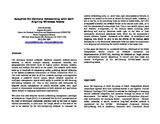Adaptive on-demand networking with self-aligning wireless nodes
| dc.contributor.author | Bordetsky, Alex | |
| dc.contributor.author | Bourakov, Eugene | |
| dc.date | 2006 | |
| dc.date.accessioned | 2013-09-05T22:05:30Z | |
| dc.date.available | 2013-09-05T22:05:30Z | |
| dc.date.issued | 2006 | |
| dc.identifier.citation | Adaptive on-demand networking with self-aligning wireless nodes overview with interactive demo of ground (swf) and maritime (swf) operation - Alex Bordetsky and Eugene Bourakov | |
| dc.identifier.uri | https://hdl.handle.net/10945/35925 | |
| dc.description | Includes a .doc version to provide an adaptive on-demand networking with self-aligning wireless nodes overview with interactive demo of ground (swf) and maritime (swf) operation. by Alex Bordetsky and Eugene Bourakov. | en_US |
| dc.description | Center for Network Innovation and Experimentation (CENETIX) Publication | en_US |
| dc.description.abstract | The emerging tactical networks represent complex network-centric systems, in which multiple sensors, unmanned vehicles, and geographically distributed units of highly mobile decision makers, transfer and analyze data while on the move. The network could easily scale up to hundreds of cooperating nodes, providing tactical extension to the system-of-systems environment of Global Information Grid [1]. The node mobility as well as ad hoc network topology reconfiguration becomes a powerful control option, which network operators or intelligent management agents could apply to provide for self-forming, self-healing behavior [2]. This in turn requires new techniques for adaptive remote management of mobile wireless nodes; their rapid remote or autonomous reconfiguration at both physical and application layers, subject to changing operational requirements. We name this new adaptive tactical networking management paradigm as Network-on-Target (NoT). It is assumed that the NoT process starts at the level of Situational Awareness Interface used by the local or higher echelon commander, to point onto the Target, which in this case is the site to be reached by the self-configuring network. In response the mobile networking node, i.e. small boat, light reconnaissance vehicle, or operator are moved to the area to extend the tactical mesh. However, if site is too far, or the preceding links are about to break down, the UAV is deployed to stretch the network further to the remote most node , or to heal the overstretched intermediate link. This in turn would require rapid and frequent re-alignment, of the antenna assets including panel switching and tune-up decisions made right at the level of local commander situational awareness view. More so, the commander’s remote advisers, located thousands miles away of surveillance and targeting area would be able to see the effects of the healing assets deployment in the Situational Awareness view and assist the commander in re-aligning and stretching the mobile network to the target area. In this paper we describe an innovative solution, developed at the Naval Postgraduate School Center for Network Innovation and Experimentation (CENETIX), enabling the Network-on-Target process by multiplatform control (separation of control and data links) and remote re-alignment of the self-forming OFDM-based tactical networking assets. | en_US |
| dc.title | Adaptive on-demand networking with self-aligning wireless nodes | en_US |
| dc.type | Article | en_US |
| dc.contributor.department | Information Science |






